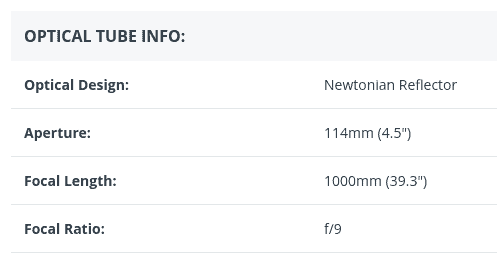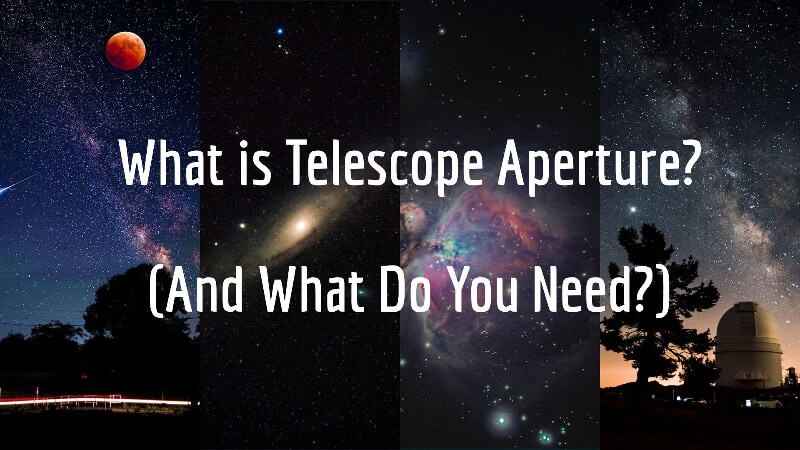The specifications of a telescope are confusing – aperture, focal length, magnification? Just what matters and what tells you how good a telescope actually is?
Well, Aperture is probably the most important thing you should pay attention to when buying a telescope.
But what is telescope aperture and what is a good aperture for a telescope? Read on to understand all you need to know.
What is Telescope Aperture?
Aperture is a measurement of a telescope’s light collecting capacity. It is determined by the:
- Size of the lens for refractor telescopes, or
- Size of the mirror for reflector and catadioptric/compound telescopes.
This difference is just because refractor telescopes use lenses, reflector telescopes use mirrors, and compound telescopes use a combination of both.
The reason aperture is important is that telescopes are designed to be used at night, in low light, for astronomy and/or astrophotography.
Their purpose of providing you with a better view than you can get with your naked eyes and they do this by collecting light to be viewed by you through an eyepiece.
Therefore, there are two key things to know about telescope aperture:
- Aperture is the best indicator of how good a telescope will be
- The higher the aperture, the better the views your telescope will provide
This is because the higher the aperture, the more light it will be able to collect and the brighter and clearer your views will be.
Having a low aperture but high magnification or focal length is useless since all it will be doing is magnify unclear views – i.e. you are just zooming more into dim, blurred views.
How to Know the Aperture of a Telescope?
Telescope aperture is a figure that is given in either inches or millimeters and is usually made clear in the model name of the telescope.
For example:
- Celestron AstroMaster 70AZ Telescope = 70mm aperture (2.8-inch)
- Sky-Watcher StarTravel 120 Telescope = 120mm aperture (4.7-inch)
- Orion SkyQuest XT8 Dobsonian Telescope = 8-inch aperture (203mm)
There is no specific reason why this is sometimes in inches and sometimes in millimeters, it is just one of those quirks.
Even single manufacturers can alternate what they use within the same range or telescope. For example, the Celestron Starsense Explorer 8 (8-inch aperture) and Celestron Starsense Explorer DX102 AZ (102mm aperture).
If, for some reason, the aperture is not clear in the name of the model then it should be easy to spot from the specifications on the manufacturer site or the retailer selling the telescope. For example:


Telescope Aperture Sizes & Comparison
Telescope aperture ranges from 50mm (2-inch) to 400mm (16-inch) for models you can buy from regular retailer.
Huge specialist telescopes can go anything up to 65-inches (1651mm) – see the most powerful telescopes you can buy for more on this.
Just for a fun comparison:
- Hubble Space Telescope has 94-inch aperture,
- James Webb Space Telescope has 256-inch aperture,
- Gran Telescopio Canarias has 410-inch aperture.
What is the Best Aperture for a Telescope?
Our recommendation is to buy a telescope with minimum 70mm aperture (2.8-inch).
Any less than this and it will be so limited in the views it provides that you will likely be disappointed and give up.
Our broad categorization for telecsope aperture is:
- 50mm to 60mm aperture: Not recommended as this is too small
- 70mm to 90mm aperture: Good minimum range for basic telescopes at budget prices
- 100mm to 200mm aperture: Intermediate range, costing more but providing much better views
- 200mm+ aperture: Advanced telescopes. High prices but with the best views.
Telescope Aperture and Focal Length
Focal length is another key specification of a telescope but it is not a good indictor of “power”.
Rather it indicates how wide or narrow the field of view will be and higher is not necessarily better.
For example:
- For viewing planets a high focal length is good because you want high magnification to zoom right in and see details, but
- For viewing some deep sky objects like nebulae you actually want lower focal length for a wider field of view to capture it all.
Telescope Aperture and Astrophotography
Whilst higher aperture is better, there is some caveat to this for astrophotography. This is because:
- With astrophotography you track the object you are photographing and take long exposures to collect the light you need to produce the image. Therefore the long exposure does the job at light collecting that aperture does for astronomy/observing.
- Higher aperture means a heavier telescope (or Optical Tube Assembly – OTA). This puts more demand on the mount you are using and so can increase tracking errors.
This is why some astrophotographers prefer to use smaller telescopes for astrophotography.
See the best telescopes for astrophotography for more on this.
FAQs: Telescope Aperture
What is a good aperture for a telescope?
For even basic astronomy you will want at least 70mm (2.8-inch) aperture. Any lower than this and the views will be disappointing and likely limit you to looking at the moon.
Is a higher aperture better for telescopes?
The higher the aperture of your telescope, the better the views it will provide.
The only downsides to this are that higher aperture costs more and results in a heavier telescope.
What is the best aperture for viewing planets?
The higher the aperture the better for viewing planets but you will also want to have a high focal length of 1000mm+ for good magnification and a narrow field of view.
Verdict: What is a Good Aperture for a Telescope?
If buying your first telescope, or considering getting one for a family member or friend, then we recommend going for at least 70mm aperture so that it can provide worthwhile views.
Any lower than this and you will likely be disappointed. Going for a higher aperture will provide better views but it will also cost you more and the telescope will be bigger and heavier.
Related Articles:



